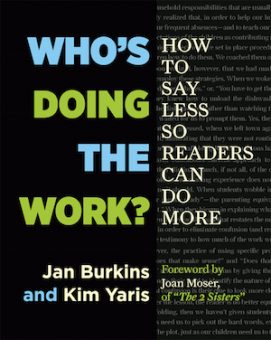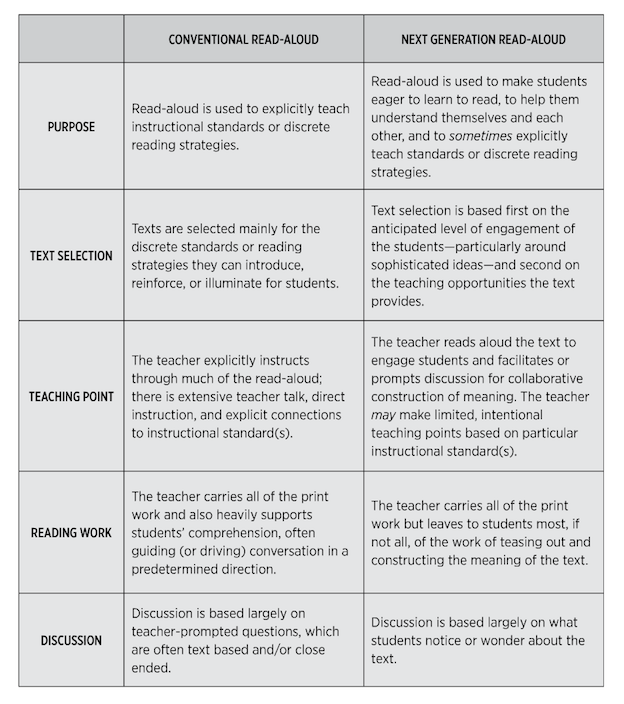Teaching Reading to a New Generation of Students
Who’s Doing the Work? How to Say Less So Readers Can Do More
Jan Burkins and Kim Yaris
(Stenhouse, 2016 – Learn more)
Burkins and Yaris’ Who’s Doing the Work was a natural choice for my next Middleweb review! Although I was unfamiliar with the work of Kim Yaris, I felt that I “knew” Jan Burkins already. She first came to my attention as I was beginning my stint as my district’s first ever literacy coach.
An awesome responsibility, to be sure, but thanks to the steady wisdom and guidance I received from reading Burkins’ excellent books on literacy coaching, Practical Literacy Coaching and Coaching for Balance, I was able to dive into the coaching responsibilities with confidence. So choosing to review this book was like taking the opportunity to once again visit with a trusted friend.
 Who’s Doing the Work? asks important questions about how literacy teachers approach reading instruction. Are we as teachers assuming too much of the responsibility for doing the work of reading? Are we creating “learned helplessness” in our students by scaffolding too much? How do Read Aloud, Shared Reading, Guided Reading, and Independent Reading fit into reading instruction? What is the role of the teacher in these “next generation instructional contexts”? (Burkins and Yaris 2016)
Who’s Doing the Work? asks important questions about how literacy teachers approach reading instruction. Are we as teachers assuming too much of the responsibility for doing the work of reading? Are we creating “learned helplessness” in our students by scaffolding too much? How do Read Aloud, Shared Reading, Guided Reading, and Independent Reading fit into reading instruction? What is the role of the teacher in these “next generation instructional contexts”? (Burkins and Yaris 2016)
Burkins and Yaris systematically dig into these questions throughout the course of six clearly organized chapters as they discuss what they call “next generation reading instruction.”
Let’s break the chapters down
Chapter 1, “Reading Process: Beginning with the End in Mind”, provides a discussion of just what is meant by reading processes and what systems are in play as children learn to read. If the ultimate goal of reading instruction is to teach our students to be independent, proficient readers who love to read, then what can we do to facilitate the gradual release of responsibility that accomplishes that goal? How can we empower our students to be able to tackle their reading challenges when we’re not around to guide them?
Chapters 2–5 take a detailed look at how to answer those questions through a discussion of each of the instructional contexts that comprise today’s literacy instruction:
- Chapter 2: “Read-Aloud: Giving Students a Reason to Learn to Read”
- Chapter 3: “Shared Reading: Bridging the Gap Between Read-Aloud and Guided Reading”
- Chapter 4: “Guided Reading: Reading Practice Under the Teacher’s Watchful Eye”
- Chapter 5: “Independent Reading: Learning to Love to Read”
Each chapter follows the same organizational pattern beginning with an overview of what each context is. The authors then compare the context to what it might look like in its “next generation” configuration and provide a chart pointing out the differences between the two practices.
The chapters continue by clearly mapping out how to enhance the traditional context to bring it into next generation practice. The “tricky parts” of each context, including some popular misconceptions and “cautionary tales” about each, are followed with suggestions for lesson planning, a summary, and ideas to try. (Burkins and Yaris 2016)
Gradual Release for the Next Generation
Chapter 6, “Putting It All Together”, wraps up the book with a discussion of what next generation scaffolding may look like and the importance of teaching the instructional contexts across the gradual release of responsibility.
The authors create a dance metaphor, comparing each instructional context to the process of learning how to dance so that teachers are able to “better imagine the recurring cycle of teaching and learning work that they engage in with students.”
For example, Read-Aloud is compared to watching a dance performance—a dancer-to-be watches the skilled dancing of the performer and is inspired to want to do the same—just as a student listens to the expert reading of a text well above his/her reading level and aspires to be able to read just like that. I found the dance metaphor to be a particularly effective way to clarify the gradual release of responsibility—the “ reading with the end in mind”—that is at the heart of this book.
Valuable for Teachers Across Grades K-8
Who’s Doing the Work? is a book that should be on every elementary and middle grade teacher’s book shelf. The clarity of the writing makes this book accessible to pre-service and in-service teachers as well as administrators. Although the book is designated Grades K-5, the value to middle school ELA teachers will be obvious as you read. (You can preview the entire book here.)
Next to the highly readable nature of the book, the thing I like best is the obvious respect Burkins and Yaris have for their fellow educators. This is evidenced throughout the book but particularly in the last few paragraphs when they encourage teachers to “trust your inner teacher and practice the aspects of next generation reading instruction that align with what you believe about teaching and learning. Implementation does not have to be all of one perspective and none of the other.”
It was a visit with a trusted old—and new—friend, to be sure.
Nancy Chodoroff has enjoyed a varied teaching career. Starting as an elementary teacher, she “graduated” to middle school where she taught reading, American History, and served as a master teacher before becoming her district’s first Literacy Coach. She also had the privilege of serving on a national Middle Level Task Force in Washington, DC, and as an adjunct professor in Rider University’s College of Education (Lawrenceville, NJ). Nancy continues to share her love of teaching through her current work with Rider’s National Writing Project chapter.



































